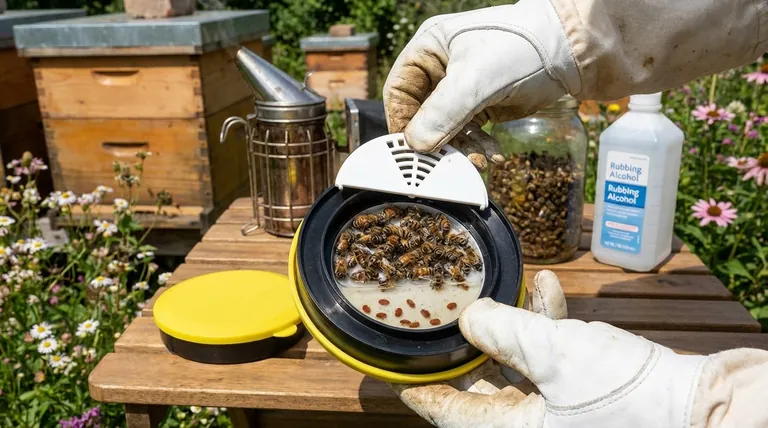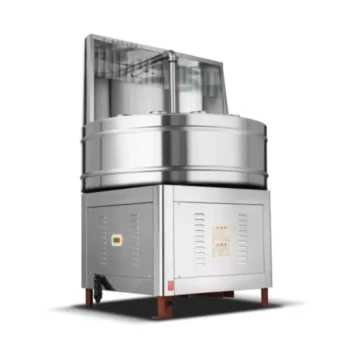At its core, the alcohol wash is a diagnostic tool. Its purpose is to give a beekeeper an accurate and fast measurement of the Varroa mite infestation rate within a honey bee colony. By sampling a small subset of adult bees, a beekeeper can quantify the mite load and make an informed, data-driven decision about whether treatment is necessary.
The true purpose of the alcohol wash is to move beyond guesswork in hive management. It replaces subjective observation with a clear, quantitative metric, empowering the beekeeper to intervene precisely when needed to protect the colony's health.

Why Mite Monitoring is Crucial
Varroa mites are one of the most significant threats to honey bee health worldwide. Relying on simple visual inspection is ineffective, as the majority of mites are hidden on the underside of bees or, more critically, reproducing within capped brood cells.
The Need for a Quantitative Sample
To understand the health of the entire colony—which can contain 30,000 to 60,000 bees—a representative sample is required. An alcohol wash typically uses a sample of 300 bees.
Providing a Clear Metric
The process dislodges mites from the sampled bees, allowing for a direct count. This count is then used to calculate a simple percentage.
For example, if you find 6 mites in a sample of 300 bees, your infestation rate is 2% (6 ÷ 300 = 0.02).
Enabling Proactive Decisions
This percentage is not just a number; it is a critical piece of data. It can be compared against established treatment thresholds, which are the mite levels at which the colony's health is considered to be at risk. This allows a beekeeper to act before the colony shows visible signs of collapse.
Understanding the Trade-offs
The primary drawback of the alcohol wash method is that it is a terminal test, meaning the bees in the sample are killed. While this is unfortunate, it must be weighed against the risk of losing the entire colony.
The Sacrifice of the Sample
The ~300 bees used in the sample will perish. This is the main reason some beekeepers may hesitate to use this method.
Putting the Loss in Perspective
A healthy queen bee can lay over 1,500 eggs per day. The loss of 300 adult worker bees is a negligible sacrifice when compared to the potential death of the entire colony from a runaway Varroa mite infestation. The health of the superorganism is the priority.
Making the Right Choice for Your Goal
The data from an alcohol wash directly informs your treatment strategy. The decision to treat is typically based on exceeding a specific mite percentage, known as a treatment threshold.
- If your primary focus is proactive colony protection: Treat when your alcohol wash shows an infestation rate at or near the common 2% threshold (6 mites per 300 bees).
- If your primary focus is minimizing chemical treatments: You might adopt a slightly higher threshold of 3% (9 mites per 300 bees), but this comes with an increased risk to long-term colony survival.
Ultimately, systematic monitoring with an alcohol wash empowers you to manage your colonies based on evidence, not assumptions.
Summary Table:
| Purpose | Key Metric | Sample Size | Primary Benefit |
|---|---|---|---|
| Quantify Varroa mite infestation rate | Infestation Percentage (e.g., 2%) | ~300 bees | Enables proactive, data-driven treatment decisions to prevent colony collapse |
Protect Your Investment with Data-Driven Beekeeping
Accurate mite monitoring is the cornerstone of modern apiary management. For commercial apiaries and beekeeping equipment distributors, protecting the health of your colonies is paramount to your operation's success.
HONESTBEE supplies the reliable beekeeping supplies and equipment you need for effective monitoring and treatment. We understand the critical balance between proactive hive protection and operational efficiency.
Let us help you make informed decisions. Our wholesale-focused operations are designed to support your business with the quality tools required for systematic health checks.
Contact HONESTBEE today to discuss your apiary's needs and ensure your colonies thrive.
Visual Guide

Related Products
- Adjustable Formic and Acetic Acid Dispenser for Bee Mite Treatment
- Professional 3-Bar Frame Grip with Integrated Hive Tool
- HONESTBEE Advanced Ergonomic Stainless Steel Hive Tool for Beekeeping
- Professional Dual-End Stainless Steel Hive Tool for Beekeeping
- Plastic Chinese Queen Grafting Tool for Bee Queen Rearing
People Also Ask
- What is the focus of hive management during summer? Maximize Your Honey Harvest with Expert Tips
- What should beekeepers do to manage varroa mites effectively? Adopt a Proactive Monitoring Strategy
- What are some common predators and pests that target beehives? Protect Your Hives from Bears, Mites, and Beetles
- What are the symptoms of Varroa Mite Syndrome (VMS)? Recognizing the Signs of Colony Collapse
- How do Varroa mites spread between honey bee colonies? Stop Mite Transmission in Your Apiary



















